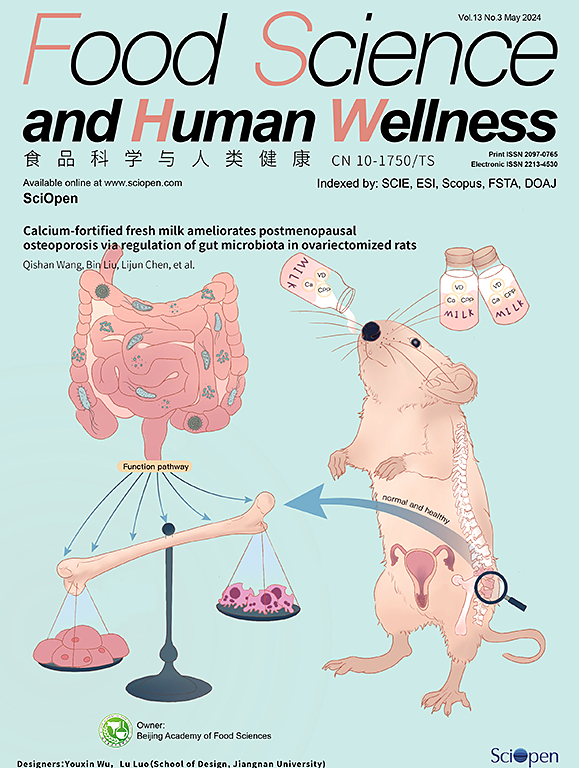Effects of excessive body fat on colostrum lipid patterns: overweight/obese vs. normal weight mothers
IF 7.4
1区 农林科学
Q1 FOOD SCIENCE & TECHNOLOGY
引用次数: 0
Abstract
Prenatal overweight/obesity (OW/OB) can alter colostrum lipid patterns, thereby affecting the lipid metabolism and even the cognitive and healthy development of infants. However, studies on changes in colostrum lipids in the context of OW/OB are limited, particularly for glycerides and polar lipids. Therefore, this study investigated the influence of maternal prenatal weight on colostrum in lipid subclasses and molecular species. The concentration of triacylglycerols (TAGs) in the colostrum of the OW/OB group (35 894.43 mg/L) was higher than that of the normal weight (NW) group (26 639.20 mg/L), suggesting that colostrum from OW/OB mothers could provide more energy to their infants. Further analysis of the fatty acid composition of TAGs revealed that elevated maternal body weight enhanced the concentration of TAGs containing saturated or n-6 fatty acids and shortened the carbon number of TAGs. Docosahexaenoic acid (DHA)/arachidonic acid (AA)/choline-containing lipids, such as DHA-containing TAGs, AA/DHA-containing phosphatidylethanolamine, and choline-containing phospholipids, were present in higher levels in the colostrum of OW/OB mothers than NW mothers. However, the concentrations of palmitic acid-containing TAGs, linoleic acid-containing TAGs, dihomo-γ-linolenic acid-containing TAGs, and polar lipids and the ratio of TAGs containing n-6 fatty acid/n-3 fatty acid were significantly higher in the colostrum of OW/OB mothers than in that of NW mothers. The fatty acid composition and sphingoid bases of sphingolipids were also altered due to elevated body weight. In conclusion, OW/OB affects colostrum lipids with respect to composition, concentration, and percentage. Although the colostrum of healthy OW/OB mothers can provide sufficient DHA/AA/choline-containing lipids to their infants, normalization of body weight and fat reserves should be considered as a strategy for high-quality human milk lipids.
过量体脂对初乳脂质模式的影响:超重/肥胖与正常体重的母亲
产前超重/肥胖(OW/OB)可以改变初乳脂质模式,从而影响脂质代谢,甚至影响婴儿的认知和健康发育。然而,关于OW/OB背景下初乳脂质变化的研究有限,特别是甘油和极性脂质。因此,本研究从脂质亚类和分子种类两方面探讨了母体产前体重对初乳的影响。OW/OB组初乳中甘油三酯(triacylglycerols, TAGs)浓度为35 894.43 mg/L,高于正常体重(NW)组(26 639.20 mg/L),表明OW/OB组初乳可以为婴儿提供更多的能量。进一步分析tag的脂肪酸组成发现,母亲体重的增加增加了含有饱和脂肪酸或n-6脂肪酸的tag的浓度,缩短了tag的碳数。二十二碳六烯酸(DHA)/花生四烯酸(AA)/含胆碱的脂质,如含DHA的TAGs、含AA/含DHA的磷脂酰乙醇胺和含胆碱的磷脂,在OW/OB母鼠初乳中的含量高于NW母鼠。然而,OW/OB母鼠初乳中含棕榈酸标签、含亚油酸标签、含二homo-γ-亚麻酸标签、极性脂的浓度和含n-6脂肪酸/n-3脂肪酸标签的比例显著高于NW母鼠。脂肪酸组成和鞘脂的鞘碱也因体重升高而改变。综上所述,OW/OB影响初乳脂质的组成、浓度和百分比。虽然健康的OW/OB母亲的初乳可以为婴儿提供足够的DHA/AA/含胆碱的脂质,但体重和脂肪储备的正常化应被视为获得高质量人乳脂质的策略。
本文章由计算机程序翻译,如有差异,请以英文原文为准。
求助全文
约1分钟内获得全文
求助全文
来源期刊

Food Science and Human Wellness
Agricultural and Biological Sciences-Food Science
CiteScore
8.30
自引率
5.70%
发文量
80
审稿时长
28 days
期刊介绍:
Food Science and Human Wellness is an international peer-reviewed journal that provides a forum for the dissemination of the latest scientific results in food science, nutriology, immunology and cross-field research. Articles must present information that is novel, has high impact and interest, and is of high scientific quality. By their effort, it has been developed to promote the public awareness on diet, advocate healthy diet, reduce the harm caused by unreasonable dietary habit, and directs healthy food development for food industrial producers.
 求助内容:
求助内容: 应助结果提醒方式:
应助结果提醒方式:


